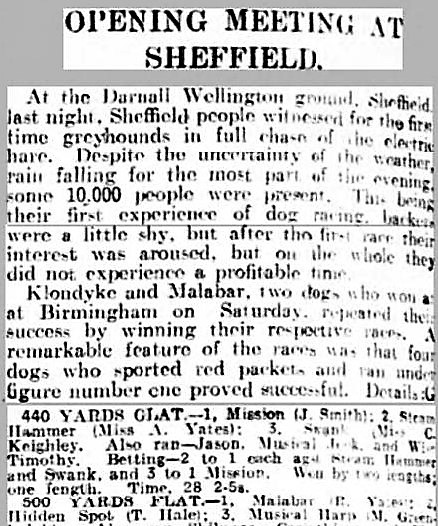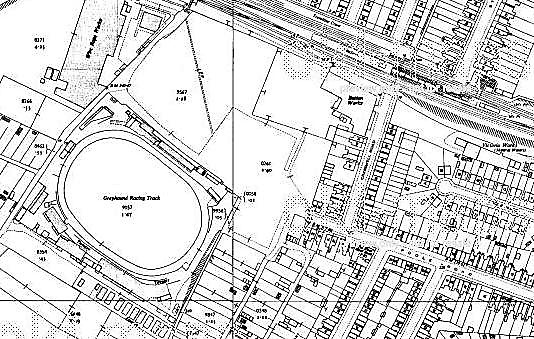Poole Road, Darnall, Sheffield, South Yorkshire.
POSTCODE———————————–S9 4LR
LOCATED———————————— About two and a half miles east of Sheffield city centre in the District of Darnall, situated at the end of Poole Road and to the east of Acres Hill Lane.
ORIGINAL SITE——————————Wellington Cricket Ground.
DATE CONSTRUCTED———————1927
DATE VENUE OPENED——————–May 1927.
Meaning other sports may have taken place prior to the arrival of Greyhound Racing.
FIRST MEETING—————————–May 23rd 1927, over 5,000 patrons witnessed a greyhound named Mission win the first race.
Greyhound Racing only.
LICENSED OR INDEPENDENT———–NGRC.
All venues covered would have to be licensed with the government, licensed suggested in this section would refer to tracks operating under NGRC Rules.
INSIDE OR OUTSIDE HARE TYPE——-Inside Sumner.
Please note that the Electric Hare suggested is only a guidance, and would have been in operation for a certain amount of time at this venue. Although it is not necessarily guaranteed that it was operational all the time, as other types of lure may have been used and updated as time progressed.
DISTANCES———————————–474, 530 and 650 yards.
Please note that most racing venues distances had become varied throughout the years, the ones given above were at once point set and offers only a guidance to the track size.
CIRCUMFERENCE—————————Dont know.
Please note that alterations at most racing venues throughout its existence would see that the circumference of the track would vary, the one shown above offers only a guidance to the track size.
BIG RACE NAMES—————————The Sheffield Cup.
STADIUM SHARED WITH——————Football, cricket and Show jumping.
LAST MEETING——————————-November 28th 1964.
Greyhound Racing only.
STADIUM CLOSURE DATE—————-1964
Meaning other sports may have taken place after Greyhound Racing had ceased.
STADIUM DEMOLITION——————–Mid 1960’s.
BUILT ON SITE——————————–Arden Winch Company on Acres Hill Lane now covers the site.
In some cases, structure’s that originally covered the venue after the stadium had been demolished, may have been themselves demolished too, so the one described is more likely to be the one which now presently covers the site.
EVIDENCE LEFT TODAY——————–Nothing known of.
FURTHER COMMENTS———————None










The South Yorkshire city of Sheffield has had its fair share of greyhound racing venues over the years with certainly Owlerton Stadium becoming the first to spring to mind. Another of the tracks was the flapping venue at Hyde Park, but this section describes it’s other NGRC track, the one at Darnall. When reading down the list of pioneering greyhound tracks, Sheffield is mentioned and one presumes it’s the one at Owlerton, but it was Darnall who became Sheffield’s first.
The birth of the Darnall Greyhound Racecourse came in 1927, under the promotion of the AGR, The Associated Greyhound Racecourse Company, a totally different company from the GRA, who had already been successful in spreading Greyhound Racing across the UK. Darnall had become the second track under The AGR to surface, opening on the 23rd of May 1927, only two days after the Birmingham’s Kings Heath Track, and only the fourth licensed track to emerge in the UK behind Manchester’s Belle Vue and Liverpool’s Breck Road.
It was situated roughly two and a half miles east of Sheffield city centre in the district of Darnall, half a mile south of Darnall’s Railway Station, and had been developed on the site of the abandoned Wellington Cricket Ground. The first meeting had attracted a gathering of around 5 to 6,000 racegoers who had paid to witness a greyhound called Mission win the ten-pound prize money on offer. The future of the sport looked promising at Darnall, with five meetings per week being staged, but revised betting laws set by the government, forced the reduction of the number of meetings allowed per year, had seen the AGR drift into liquidation in 1933.
Darnall recovered by being taken over by new management, who continued to operate under NGRC rules right up until its closure in 1964. Races consisted of five greyhounds contesting over distances of 475, 530 and 650 yards, with the hounds chasing an inside Sumner type hare. Darnall unlike the majority of greyhound venues, did not share its facilities with motor sports, as the only other sporting activity regularly used at the venue was Show Jumping, therefore income was relatively down to greyhound racing.
The decline of Darnall could be blamed on new government legislation introduced in 1961, which witnessed the introduction of legalised betting shops, and most certainly would have contributed to the falling attendances at the track. Darnall’s final meeting came on the 28th of November 1964, it remained stagnant over the following months, before the bulldozers moved in and flattened all structures. The site remained neglected for almost 20 years before the eastern side of the track was sold with a view of redeveloping the site. But it would take almost another ten years before any construction work began.
Today, part of the site is covered by housing on Collister Drive, with the Western side covered by industrial units, with Poole Road becoming a feeder road for the industrial site. A company known as Arden Winch’s now pinpoints its exact location to were Darnall Stadium once lay.

Recent Comments